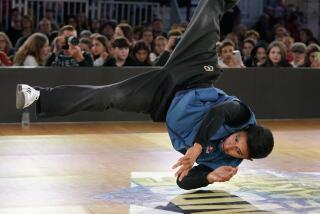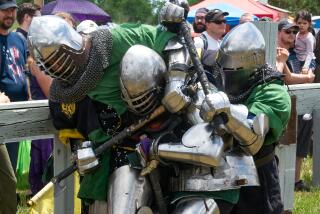Pointed observations on an ancient sport
- Share via
By the Sword
A History of Gladiators, Musketeers, Samurai, Swashbucklers, and Olympic Champions
Richard Cohen
Random House: 520 pages, $29.95
*
Richard Cohen writes of fencing that “of all sports arguably the most romantic, it also most closely simulates the act of armed manslaughter.” A five-time national saber champion in Britain and member of the British team in four Olympics, Cohen hangs on this observation an exhaustive book on the history of swords and swordsmanship.
Fencers and other sword fanciers will be engrossed by the details of “By the Sword: A History of Gladiators, Musketeers, Samurai, Swashbucklers, and Olympic Champions.” Others will discover in it a more ambiguous picture of life, in which death and the ways to inflict it become entwined with personal honor, technological improvements and, yes, elegance and beauty.
Much as Patrick O’Brian, in his novels about the royal navy in the Napoleonic Wars, revived the seafaring past of the English tongue, Cohen reminds us that it is easy to find vestiges of swordsmanship in modern society and that it is common in all modern languages to find metaphors and aphorisms for thrusting, cutting and slashing.
“We shake hands,” he writes, “to show that we are not reaching for our swords; a gentleman offers a lady his right arm because at one time his sword was at his left hip; a man’s coat buttons left over right, so that a duelist might unbutton it with his left, unarmed hand. The two main parties in the House of Commons are separated by the precise length of two sword blades; and each MP’s locker still contains a loop of silk on which to hang up his sword. Kamikaze pilots took their samurai swords with them into their cockpits.”
Cohen surveys the history of metallurgy and swords around the world. He quotes R. Ewart Oakeshott, an authority on early arms, as believing that swords first appeared between 1500 and 1100 BC in Minoan Crete and Celtic Britain. The earliest known depiction of fencing is in a temple built around 1190 BC near Luxor in upper Egypt by Ramses III. The Chinese, Japanese, Persians, Babylonians and Romans sometimes fenced as a pastime, but fencing was mostly used by soldiers in combat. Ancient Hindu legend recounts that the god Brahma taught his priest-warriors martial exercise with the sword.
By the European Middle Ages, the sword had become the symbol of dominion and kingship. And even as the longbow and then gunpowder pushed the sword from center stage in combat, it took on in Europe a new aura of personal skill and manliness. Here began the romance, if that is what it truly is, of fencing and swordsmanship that persists to this day. And began too the custom -- or rather the fashion -- of dueling.
Cohen is good on how dueling came about, but short on the why. It seems to have been an expression of individuality as, in the 18th and 19th centuries, societies moved from emphasis on hierarchy to that of the individual (and the exquisite as well as, perhaps, absurd cultivation of personal points of honor). Dueling was intimately related to the Romantic movement in art, music and sensibility.
In cinema, fencing had become fun and games. Cohen has a lively section on fencing in films. He writes that Alexandre Dumas, author of “The Three Musketeers,” “did more to popularize swordfighting than anyone in history -- because so many people read him and because he created the archetypes who would reign again in cinema.”
Hollywood had its fencing masters too. Cohen thinks the best fencing actors were Douglas Fairbanks Sr. and Errol Flynn, because they did it themselves.
Cohen quotes from a letter to him from Nicolo Perno, who coached both the Italian and German national teams in the fascist years: “The fencing strip has always seemed to me a metaphor for life itself: he who knows how to move on it, how to overcome a rival by honest means, has really discovered how life itself must be.” Many fencers have said similar things of the sport, and readers of “By the Sword” are entitled to wonder which element, romance or combat, outweighs the other.
More to Read
Sign up for our Book Club newsletter
Get the latest news, events and more from the Los Angeles Times Book Club, and help us get L.A. reading and talking.
You may occasionally receive promotional content from the Los Angeles Times.










